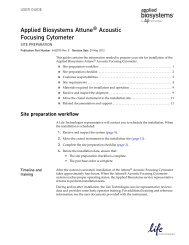miRNA Research Guide - Applied Biosystems
miRNA Research Guide - Applied Biosystems
miRNA Research Guide - Applied Biosystems
Create successful ePaper yourself
Turn your PDF publications into a flip-book with our unique Google optimized e-Paper software.
<strong>miRNA</strong> Functional Analysis<br />
<strong>miRNA</strong> functional analysis can be performed with protocols that are similar to<br />
standard genes. Up-regulation of the <strong>miRNA</strong>s can be conducted to identify gainof-function<br />
phenotypes; down-regulation or inhibition can be conducted to<br />
identify loss-of-function phenotypes (Table 2 and Figure 22). The combination of<br />
up- and down-regulation can be used to identify genes that are regulated by specific<br />
<strong>miRNA</strong>s as well as to identify cellular processes that are affected by specific<br />
<strong>miRNA</strong>s (Figure 23).<br />
Key applications include:<br />
• <strong>miRNA</strong> target site identification and validation<br />
• Screening for <strong>miRNA</strong>s that regulate the expression of a gene<br />
• Screening for <strong>miRNA</strong>s that affect a cellular process<br />
Up-regulation of <strong>miRNA</strong>s in cells can be accomplished either by transfecting cells<br />
with synthetic <strong>miRNA</strong>s [1, 2] or plasmids that express <strong>miRNA</strong>s [3]. The use of<br />
synthetic molecules has several advantages (Table 3):<br />
• The transfection efficiency of small RNAs can approach 100% for immortalized<br />
cells. The high transfection efficiencies of synthetic <strong>miRNA</strong>s are particularly<br />
beneficial for high-throughput applications like <strong>miRNA</strong> functional screening.<br />
• Small RNAs like <strong>miRNA</strong>s can be readily electroporated into primary cells without<br />
inducing significant cell death.<br />
• Synthetic <strong>miRNA</strong>s can be transfected at several different concentrations, facilitating<br />
dose response studies.<br />
• Unlike plasmid-induced <strong>miRNA</strong>s, the sequence of the synthetic <strong>miRNA</strong> that is<br />
altering translation is defined. The rules for <strong>miRNA</strong> excision and activation are<br />
not fully understood, making it difficult to ensure uptake and activation of the<br />
intended <strong>miRNA</strong> molecule expressed from a plasmid.<br />
12<br />
microRNA Functional Analysis<br />
Table 2. Products for <strong>miRNA</strong> Functional Analysis.<br />
Product<br />
Pre-miR <strong>miRNA</strong><br />
Precursor Molecules<br />
Anti-miR <strong>miRNA</strong> Inhibitors<br />
pMIR-REPORT <strong>miRNA</strong><br />
Expression Reporter Vector<br />
Endogenous<br />
<strong>miRNA</strong><br />
Pre-miR<br />
<strong>miRNA</strong><br />
Precursor<br />
Molecules<br />
Anti-miR<br />
<strong>miRNA</strong><br />
Inhibitors<br />
3' 5'<br />
Sequence-specific loading<br />
into RISC-like complex<br />
3' 5'<br />
Sequence-specific loading<br />
into RISC-like complex<br />
3' 5'<br />
Complementary binding of<br />
specific <strong>miRNA</strong>s—no RISC-like<br />
complex association<br />
Function<br />
Synthetic <strong>miRNA</strong> molecules for<br />
up-regulation of <strong>miRNA</strong> activity<br />
Synthetic <strong>miRNA</strong> inhibitors that reduce <strong>miRNA</strong> activity<br />
Accurate, quantitative <strong>miRNA</strong> reporter<br />
vector to monitor <strong>miRNA</strong> activity<br />
5'Cap AAAAAAAAAAAAAA 3'<br />
3' 5'<br />
5'Cap AAAAAAAAAAAAAA 3'<br />
3' 5'<br />
5'Cap AAAAAAAAAAAAAA 3'<br />
No translation<br />
No translation<br />
Translation<br />
Figure 22. Activity of Pre-miR <strong>miRNA</strong> Precursor Molecules and Anti-miR <strong>miRNA</strong><br />
Inhibitors.<br />
Correct strand<br />
uptake<br />
Tight regulation of <strong>miRNA</strong><br />
concentration<br />
Defined functional<br />
sequence<br />
www.ambion.com/<strong>miRNA</strong><br />
Table 3. Comparison of Synthetic <strong>miRNA</strong>s Versus Other Technologies.<br />
Cell Number<br />
Pre-miR Synthetic<br />
<strong>miRNA</strong> Design<br />
High transfection<br />
efficiency •<br />
200<br />
180<br />
160<br />
140<br />
120<br />
100<br />
80<br />
60<br />
40<br />
20<br />
0<br />
miR-24<br />
miR-21<br />
•<br />
•<br />
•<br />
Anti-miR <strong>miRNA</strong> Inhibitors<br />
Vector Expression<br />
Design<br />
miR-190<br />
•<br />
miR-218<br />
siRNA Design<br />
Figure 23. Identification of <strong>miRNA</strong>s that Alter Cell Proliferation. HeLa cells (5 x 10 3 ) were transfected<br />
with individual Anti-miR <strong>miRNA</strong> Inhibitors in triplicate using siPORT NeoFX Transfection Agent<br />
(Ambion). 72 hr post-transfection, cells were fixed and stained with propidium iodide to look at total cell number.<br />
Cells were then stained for β-actin using immunofluorescence. The shaded horizontal area represents<br />
the normal range of cell number for this cell type, as exemplified by cells transfected with a GAPDH antisense<br />
transcript that does not affect cell proliferation (second bar from the right).<br />
Anti-miR <strong>miRNA</strong> Inhibitors<br />
The easiest way to knockdown specific <strong>miRNA</strong> activity<br />
Product Description<br />
The Anti-miR <strong>miRNA</strong> Inhibitors are sequence-specific and chemically modified<br />
to specifically target and knockdown individual <strong>miRNA</strong> molecules.<br />
REFERENCES<br />
1. Lewis BP, Shih IH, Jones-Rhoades MW, Bartel DP, Burge CB. (2004) Prediction of mammalian microRNA<br />
targets. Cell 115(7):787–798.<br />
2. Cheng, A. M., Byrom, M. W., Shelton, J., Ford, L. P. (2005) Antisense inhibition of human <strong>miRNA</strong>s and indications<br />
for an involvement of <strong>miRNA</strong> in cell growth and apoptosis. Nucleic Acids Res 33:1290–1297.<br />
3. Zeng Y, Wagner EJ, Cullen BR. (2002) Both natural and designed micro RNAs can inhibit the expression<br />
of cognate mRNAs when expressed in human cells. Mol Cell 9:1327–1333.<br />
ORDERING INFORMATION<br />
Product Cat. # SIZE<br />
mirVana <strong>miRNA</strong> Probe and Marker Kit 1554 30 rxns; 10 marker rxns<br />
Anti-miR <strong>miRNA</strong> Inhibitors 17000 5 nmol<br />
order online at www.ambion.com/catalog/mirna_search.php<br />
17001 20 nmol (4x5 nmol)<br />
Anti-miR <strong>miRNA</strong> Inhibitors –<br />
custom defined sequence<br />
order online at www.ambion.com/catalog/mirna_search.php<br />
17003 20 nmol<br />
Anti-miR Negative Control #1 17010 5 nmol<br />
•<br />
•
















